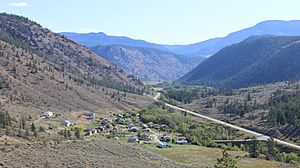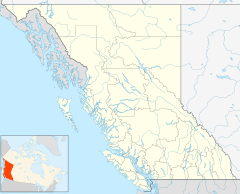Pavilion, British Columbia facts for kids
Quick facts for kids
Pavilion
Ts'kw'aylaxw, Tsk'waylacw,
or Tsk'weylecw |
|
|---|---|
|
Ranching & Indian reserve community
|
|
 |
|
| Country | |
| Province | |
| Region | Fraser Canyon/Lillooet Country |
| Regional district | Squamish-Lillooet |
| Elevation | 2,390 ft (730 m) |
| Area codes | 250, 778, 236, & 672 |
| Highways | |
Pavilion is a small community located on the eastern side of the Fraser River in southwestern British Columbia. It's found near what was once 'Mile 21' on the historic Old Cariboo Road. You can reach Pavilion by Highway 99, about 36 kilometers (22 miles) northeast of Lillooet and 135 kilometers (84 miles) west of Kamloops.
Contents
First Nations History and Culture
The original name for this village was Skwailuk. This word means "hoar-frost," which might describe how the ground stayed frozen in the long, cold winters.
The Ts'kw'aylaxw First Nation lives here. They are also known as the Tsk'waylacw First Nation or Tsk'weylecw First Nation. Most people in the area belong to this First Nation.
The language spoken in Pavilion is a mix of St'at'imcets and Secwepemc'tsn. Many local place names come from the Secwepemc'tsn language.
How Pavilion Got Its Name
In 1859, Lieutenant Mayne of the Royal Engineers noticed something interesting. He saw that the local Indigenous people could speak some French. They had learned it from earlier fur traders.
In 1862, Mayne wrote about his travels. He remembered seeing a large white flag waving over the grave of an Indigenous chief. The word "Pavilion" is French for "tent" or "flag."
This area was an important stop on the River Trail during the Fraser Canyon Gold Rush. One idea about the flag is that it showed travelers that this was a "friendly Indian" camp. This was important because of the Fraser Canyon War that had happened further south. The flag might also have shown wealth, as cloth was a valuable trading item back then.
Early Days of the Community
In 1856, a man named David Reynolds started living near Pavilion Creek. This was close to Pavilion Lake. Later, in 1858, Captain John Martley claimed a large piece of land nearby. When Reynolds left, Martley was given his land too.
Martley's ranch was called "The Grange." It grew to be almost 1,000 acres (400 hectares). His home at "22 Mile" was a stop for stagecoaches. Martley also ran a business that moved goods between Ashcroft and Lillooet.
Around 1859, Pavilion had about 20 huts for miners. These huts were a place for miners to get ready before heading out to look for gold.
Over the years, more businesses opened. In the 1860s, William Lee started a general store. He also built a flour mill in 1872, which ground grain into flour. This mill was still working in 1909. Pavilion also had a post office that opened and closed a few times before staying open from 1905 onward.
The Lee general store building changed over time. By the 1950s, it was a bed and breakfast, a restaurant, a post office, and a gas station. Sadly, a fire destroyed the building in 2000. There was also a community hall in Pavilion at one time.
Roads and Transportation
The roads around Pavilion slowly improved over time. By 1862, stagecoaches from Barnard's Express traveled north from Douglas all the way to Pavilion.
Ferry Crossings
For many years, there was a ferry that crossed the Fraser River near Pavilion. It was sometimes called the "20-Mile Post" or "Pavilion" ferry. This ferry was about 2.2 kilometers (1.4 miles) northwest of Pavilion.
From 1897, the government helped pay for the ferry. For a long time, it was just a rowboat. In 1938–39, a new home was built for the ferry operator. The rowboat was replaced a few times over the years.
In 1949, a new type of ferry was added. It was an aerial cable ferry that could carry two passengers. It used a cable attached to strong anchors. Two years later, a stronger cable and a bigger cage were installed. This allowed it to carry both people and goods. The rowboat was used until at least 1958, and the aerial cage ferry until 1962. It seems no ferry operated after the mid-1960s.
Railway Connections
During the building of the Pacific Great Eastern Railway (PGE), a hospital was set up in Pavilion. By late 1915, the railway tracks had passed through Pavilion.
In early 1916, passenger train service began through Pavilion to Clinton. Pavilion became a flag stop on the railway. This means the train would only stop if someone wanted to get on or off. It was about 5.1 kilometers (3.2 miles) northeast of Glen Fraser and 5.1 kilometers (3.2 miles) southwest of Moran.
Images for kids



